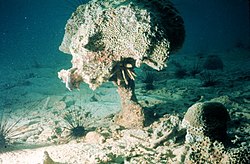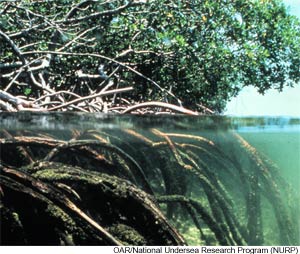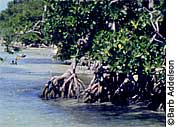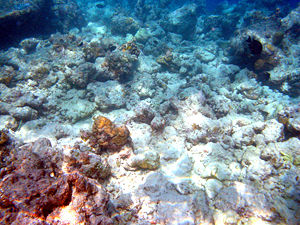SOIL MINERAL DEPLETION
Can a healthy diet be sufficient in today's world?
There was a time when simply eating a healthy diet and avoiding all anti-nutrients ensured that we got all the minerals needed to stay healthy - research today shows that this may no longer be the case as the nutrient content of our food is on the decline.

Soil is the prime source of minerals on which every living cell depends for its structure and function. Vitamins, enzymes, amino acids (protein) and a host of other biologically active substances are essential for our bodies to function properly. They virtually all include minerals as an integral part of their chemical structure. Dr Linus Pauling, twice noble prize winner, said “you can trace every sickness, every disease and every ailment to a mineral deficiency”. Yet, all over the world, minerals are disappearing from agricultural soils at an alarming rate. In 1992, the official report of the Rio Earth Summit concluded “there is deep concern over continuing major declines in the mineral values in farm and range soils throughout the world”. This statement was based on data showing that over the last 100 years, average mineral levels in agricultural soils had fallen worldwide – by 72% in Europe, 76% in Asia and 85% in North America. What has caused this staggering decline?
Most of the blame lies with artificial chemical fertilisers. We now know that plants absorb 70 to 80 different minerals from the soil, while the number returned to it by plants grown with commercial fertilisers can be counted on the fingers of one hand. Every crop that is cut or animal that is sent to market marks a further depletion in the mineral status of the soil on which it was raised. Organic wastes that in former times would have been composted and returned to the land are nowadays mostly consigned to landfill sites or incineration.
There are many other ways in which the move to chemical farming prevents crops from taking up even the sparse amounts of trace minerals left in the soil. Soil contains bacteria, fungi, plant and animal life, in a state of constant interaction and balance. Every one of these organisms needs dozens of different minerals to survive and play its part in the ecosystem. Some bacteria have a vital role in converting soil minerals into chemical forms that plants can use. NPK fertilisers (fertilisers used in modern farming that only contain nitrogen, phosphorous and potassium) gradually change the soil pH towards acidic conditions in which these bacteria can not survive. To combat soil acidification farmers lay lime on the land adding back calcium and magnesium to raise the soil pH, but it also converts manganese and some other trace minerals into chemical forms that plants are unable to absorb.
Pesticides and herbicides also reduce the uptake of trace minerals by plants. Plants have an important relationship with certain fungi that can form networks covering several acres. The fungus obtains carbohydrates from the plant root, at the same time supplying the plant with nutrients it draws from the soil. This gives the plant access to a vastly greater mineral extraction system than is possible by their roots alone. Chemical fungicide sprays destroy these beneficial fungi and so again reduce the ability of plants to absorb soil minerals. Insecticides can also reduce trace mineral uptake by inactivating choline-containing enzymes in plants, essential for the absorption of manganese and other minerals.
The combined effect of soil mineral depletion and the reduced availability of those minerals that remain is that most of the food that we eat is mineral deficient. The table below summarizes the reductions in the average mineral content of 27 vegetables and 17 fruits, between 1940 and 1991. The results of the latest research are expected to show mineral values in continual decline.
Mineral | Vegetables | Fruit | ||
| Sodium | -49% | -29% | ||
| Potassium | -16% | -19% | ||
| Magnesium | -24% | -16% | ||
| Calcium | -46% | -16% | ||
| Iron | -27% | -24% | ||
| Copper | -76% | -20% | ||
| Zinc | -59% | -27% | ||
A new study published earlier this year shows that, as might be expected, mineral levels in animal products reflect the picture in plant foods. Comparing levels measured in 2002 with those present in 1940, the iron content of milk was found to be 62% less, calcium and magnesium in parmesan cheese had each fallen by 70% and copper in dairy produce had plummeted by a remarkable 90%.
The UK government is putting resources into improving health by encouraging people to eat a healthy diet, including 5 portions of fruit and vegetables per day, but you scarcely hear a word about the problem of soil mineral depletion. Food seems to be considered as something quite separate from its source and means of production. But this is not rocket science – the foundation of human health is the quality of the food we eat, which relies ultimately on the vitality of the soil on which it is raised.
Minerals are needed for the proper formation of blood and bone, the maintenance of healthy nerve function, heartbeat regulation, reproduction and foetal development. They are essential to the process of growth, healing and energy release. And it is not just the presence of the mineral in the body that is important – they must be in the correct ratio to each other. The level of each mineral has an effect, directly or indirectly, on every other, so if one is out of kilter the whole system is affected.
Minerals are an essential part of our natural diet and a lack of them may in part account for our increasing susceptibility to the “diseases of civilisation” – such as heart disease (magnesium), cancer (selenium), diabetes (chromium) and mental illnesses (zinc). Every one of us should take care to get the minerals we need, for the good of our health.
What can you do to ensure you get the minerals you need?
Eat organic
Organic foods generally have higher levels of minerals than those grown with chemicals.
Look to the sea
A fter all this is where many minerals lost from the soil end up! Sea vegetables are particularly high in minerals. For instance, dulse seaweed contains 75 times as much iron as spring greens. Shellfish also contain good amounts of mineral especially zinc.
Take supplements
L ook for supplements that have minerals in a chelated form, or as orates, citrates or gluconates. Alternatively colloidal minerals are a good bet.
Grow your own
If your garden has not been used for growing vegetables or if you have been doing so organically, the soil is likely to be much richer in minerals than agricultural land. You won’t be able to grow all your food this way, but what you grow will be far superior nutritionally to anything you buy at the supermarket.
Campaign
Get in touch with the Soil Association or the Food Commission to get further information and find out what you can do to raise awareness of the problem of nutrient depletion. Write to your local MP or supermarket, and talk to anyone who will listen!
reference:
http://www.physicalnutrition.net/soil-mineral-depletion.htm
| |
reference:
http://kids.mongabay.com/lesson_plans/lisa_algee/deforestation.html
Coral Bleaching
Coral bleaching is the whitening of corals, due to stress-induced expulsion or death of symbiotic, algae-like protozoa, or due to the loss of pigmentation within the protozoa.[1] The corals that form the structure of the great reef ecosystems of tropical seas depend upon a symbiotic relationship with unicellular flagellate protozoa, called zooxanthellae, that are photosynthetic and live within their tissues. Zooxanthellae give coral its coloration, with the specific color depending on the particular clade. Under stress, corals may expel their zooxanthellae, which leads to a lighter or completely white appearance, hence the term "bleached".[2]
Once bleaching begins, it tends to continue even without continuing stress. If the coral colony survives the stress period, zooxanthellae often require weeks to months to return to normal density.[3] The new residents may be of a different species. Some species of zooxanthellae and corals are more resistant to stress than other species.
Causes of coral bleaching
Coral bleaching is a vivid sign of corals responding to stress, which can be induced by any of:
- increased (most commonly), or reduced water temperatures[4][5]
- increased solar irradiance (photosynthetically active radiation and ultraviolet band light)[6]
- changes in water chemistry (in particular acidification)[7][8]
- starvation caused by a decline in zooplankton[9]
- increased sedimentation (due to silt runoff)
- pathogen infections
- changes in salinity
- wind[5]
- low tide air exposure[5]
Temperature change
Temperature change is the most common cause of coral bleaching.[4]
Large coral colonies such as Porites are able to withstand extreme temperature shocks, while fragile branching corals such as table coral are far more susceptible to stress following a temperature change.[10] Corals consistently exposed to low stress levels may be more resistant to bleaching.
Factors that influence the outcome of a bleaching event include stress-resistance which reduces bleaching, tolerance to the absence of zooxanthellae, and how quickly new coral grows to replace the dead. Due to the patchy nature of bleaching, local climatic conditions such as shade or a stream of cooler water can reduce bleaching incidence. Coral and zooxanthellae health and genetics also influence bleaching.[11]
Monitoring reef sea surface temperature
The US National Oceanic and Atmospheric Administration (NOAA) monitors for bleaching "hot spots", areas where sea surface temperature rises 1 degree Celsius or more above the long-term monthly average. This system detected the worldwide 1998 bleaching event,[12][13] that corresponded to an El Niño. NOAA also uses a satellite with 50k resolution at night, which some argue covers too large a spatial area and does not detect the maximum sea surface temperatures occurring usually around noon.[citation needed]
Changes in ocean chemistry
Increasing ocean acidification likely exacerbates the bleaching effects of thermal stress.[14]
Infectious disease

It was discovered in 1996 that the bleaching agent of Oculina patagonica in the Mediterranean Sea was infectious bacteria attacking the zooxanthellae.[16] The bacteria were later identified as Vibrio shiloi.[14] V. shiloi is infectious only during warm periods. Elevated temperature increases the virulence of V. shiloi, which then become able to adhere to a beta-galactoside-containing receptor in the surface mucus of the host coral.[14][17] V. shiloi then penetrates the coral's epidermis, multiplies, and produces both heat-stable and heat-sensitive toxins, which affect zooxanthellae by inhibiting photosynthesis and causing lysis.
During the summer of 2003, coral reefs in the Mediterranean Sea appeared to gain resistance to the pathogen, and further infection was not observed.[18] The main hypothesis for the emerged resistance is the presence of symbiotic communities of protective bacteria living in the corals. The bacterial species capable of lysing V. shiloi has not been identified.
reference:
http://en.wikipedia.org/wiki/Coral_bleaching
Mangrove Ecosystem
 Mangrove forests thrive near the mouths of large rivers where river deltas provide lots of sediment (sand and mud). Mangrove roots collect sediments and slow the water's flow, helping to protect the coastline and preventing erosion. Over time, the roots can collect enough debris and mud to extend the edge of the coastline further out.
Mangrove forests thrive near the mouths of large rivers where river deltas provide lots of sediment (sand and mud). Mangrove roots collect sediments and slow the water's flow, helping to protect the coastline and preventing erosion. Over time, the roots can collect enough debris and mud to extend the edge of the coastline further out.
Mangrove forests are teeming with life. Shorebirds, crab-eating monkeys, and fishing cats all make the mangrove home. Mangroves provide a safe haven and a nursery for a variety of fish, birds, crustaceans, and shellfish.
Mangrove Trees
A mangrove is a tropical maritime tree or shrub of the genus Rhizophora. Mangroves have special aerial roots and salt-filtering tap roots that enable them to thrive in brackish water (brackish water is salty, but not as salty as sea water).
There are several species of mangrove trees found all over the world. Some prefer more salinity, while others like to be very close to a large fresh water source (such as a river). Some prefer areas that are sheltered from waves. Some species have their roots covered with sea water every day during high tide. Others are more sensitive to salinity, and grow closer to the shore. Other species grow on dry land, but are still part of the ecosystem.
Mangroves need to keep their trunk and leaves above the water line. Yet they also need to be firmly attached to the ground so they are not moved by waves. There are three types of mangrove roots that help in this process: 1. Support roots which directly pierce the soil.
1. Support roots which directly pierce the soil.
2. Level-growing roots which twist upward and downwards, with the upward twists emerging on the water surface.Any part of a root that appears above the water line channels oxygen to the plant below the water line. Over time as soil begins to build up, these roots produce additional roots that become embedded in the soil.3. Level-growing roots whose downward twists (sub-roots) appear on the water surface.
Where Are Mangroves Found?
There are 15.9 million hectares (over 60,000 square miles) of mangrove forests in the warm waters of tropical oceans all over the world. Along the Atlantic coast they are found from Florida all the way down to Argentina. Mangroves grow on both the western and eastern coasts of Africa. They stretch into India, Burma, and south-east Asia. Mangrove forests are also common in New Zealand and Australia.
Saving the Mangroves
For centuries mangrove areas have been used for timber, mining, agriculture, harbor development and human settlements. Mangrove areas were used for commercial shrimp farming during the late 70's and early 80's. However, using mangrove areas for shrimp farming proved to be unsustainable.
Many governments have realized how necessary mangroves really are to the overall environment and have adopted mangrove restoration and conservation programs. Strict legislation to protect mangroves is in place in many countries.
Indonesia is home to over a quarter of the world's mangrove population. Coastal fish farmers on the Indonesian island of Java are given 4–5 hectares of land, but are required to plant mangroves on 20% of it. Seeds are gathered from budding sprouts and planted 6 to 9 feet apart. This sort of reforestation improves the environment, while feeding people and encouraging the economy. This is a sustainable long term solution.
reference:
http://www.mbgnet.net/salt/sandy/mangroves.htm



hello! Your blog is very inspiring. As a student, it serves as an eye opener for me to really be aware of what's happening in our environment. And it made me realize that I should take care of our environment and appreciate everything around us. Keep it up! God bless. :)
ReplyDeleteKeto SLIM Max; While we do what we can to be as health-conscious as we can, it is always a work in progress since there are many elements to a healthy lifestyle. Lifelong learning is the continued educational experience that utilizes non-credit academic courses, educational travel, and community service and volunteerism to fully engage the brain, heighten physical activity, and maintain healthy social relationships. Legumes such as toor dal are a healthy source of dietary fiber, which can help to prevent constipation and promote regularity.Let's Talk asks ordinary people who have suffered from mental health issues to open themselves up and share what goes on inside their minds. 2. soundness of body or mind; freedom from disease or ailment: to lose one's health. Because of this, experts have always advised people to start their day with good and positive thoughts and words. Authors of an article published in the International Journal of Fisheries and Aquatic Studies recommended prawns as a healthy food choice due to their omega-3 fatty acid content.For many, their arrival on the border marks the beginning of a medical vacation; not a hiatus from care, but a chance to use it. It is the time when all of the prescriptions, dental fillings, and surgeries that were postponed over the course of the year because of costs and insurance limitations in the U.S. are finally addressed. In order to maintain a healthy and fit lifestyle, it's important to have some sort of consistency when looking at the big picture result. Tylko od 1 do 5% ciezko ustalic jednoznacznie zgwalconych kobiet zachodzi w ciaze, gdzie ulamek tej liczby decyduje sie na aborcje.
ReplyDeletehttp://www.garciniamarket.com/keto-slim-max/
Keto SLIM Max; If you have a history of high cholesterol or heart disease, though, play it safe by consulting with your doctor about how foods like prawns might fit into your heart-healthy diet. The United States Department of Agriculture notes that beans and peas such as toor dal can be counted in both the protein and vegetable subgroups of the government's healthy eating plan.The 23-time gold medalist is open about his struggles with mental health Before the 2016 Olympics, he talked about his struggles with depression, which he said was so debilitating sometimes that he didn't want to get out of bed or leave his room for days on end.It might take some time, but it's worth it if you want to lead a healthy lifestyle. A healthy rate of gain is about 0.5 to 1 pound per week, which requires you eat 250 to 500 calories more per day than is needed to maintain your current weight. Regular exercise and a balanced diet can strengthen your heart, but other lifestyle choices such as smoking may have a negative effect on your heart's ability to perform during exercise and recovery.Nuts, pulses, and grains are in important part of a healthy diet. Oznaczaloby to, ze skoro ludzie sa nieplodni, to znaczy, ze maja na tyle wadliwe geny, ze nie powinni sie rozmnazac a przynajmniej czesc z nich. It's the little things that you do each day that add up to being healthy and fit.Conducted by Research 2000 for the Progressive Change Campaign Committee PCCC and Democracy for America DFA, the survey finds only 33 percent of likely voters favor a health care bill that does not include a public health insurance option and does not expand Medicare, but does require all Americans to get health insurance.
ReplyDeletehttp://www.garciniamarket.com/keto-slim-max/
mmorpg oyunlar
ReplyDeleteinstagram takipçi satın al
tiktok jeton hilesi
SAÇ EKİM ANTALYA
referans kimliği nedir
İnstagram takipçi satın al
metin2 pvp serverlar
instagram takipçi satın al